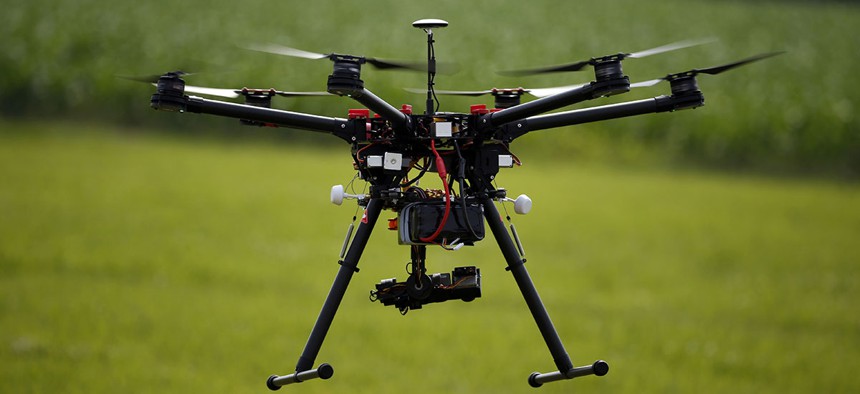The US Commercial Drone Industry Finally Governed by Real Rules

A hexacopter drone is flown during a drone demonstration at a farm and winery on potential use for board members of the National Corn Growers. Alex Brandon/AP
“License and registration, please. Do you know how fast you were going back there?”
“License and registration, please. Do you know how fast you were going back there?”
In the near future, this may well apply to commercial drone operators just as much as car drivers. After years of deliberating, forming committees, and imposing stopgap measures, the Federal Aviation Administration has finally announced a set of regulations for commercial drones.
These rules will affect anyone that wants to start a business using drones, from a one-man operation to take wedding photos from a drone, all the way up to big-box retailers like Amazon and Walmart that want to operate fleets of drones to deliver packages.
Up until now, FAA has issued special exemptions to people wanting to operate drones commercially—called Section 333 exemptions—and has issued a few thousand since setting up the system in 2012. Now, under the new rules—which FAA says will take effect in August—anyone wishing to operate a drone commercially will be able to do so without explicit permission, but they will need to have obtained a license through FAA-approved tests first.
FAA said in a release that its rules could “could generate more than $82 billion for the U.S. economy and create more than 100,000 new jobs over the next 10 years,” as businesses will no longer have to wait for the government to approve exemptions, and those waiting for clear legal requirements before entering the commercial drone operating industry now have an answer.
But some of the rules that FAA has decided upon may frustrate those hoping to run drone delivery services, such as Alphabet, which has said it plans to have a drone delivery service up and running by 2017, and Amazon, which said it would be ready to go as soon as FAA’s rules permit.
FAA’s rules state that drones cannot be flown at night, and they still must always remain within eyeshot of the pilot—that means it’s unlikely that any of the autonomous drone delivery systems companies are working on will be flying in U.S. airspace anytime soon. Companies won’t be able to have drones fly themselves whenever someone requests an item, unless Amazon, Alphabet, or Walmart plan to only deliver goods during the daytime, and only as far as their pilots can see their drones.
But that doesn’t mean things will stay this way forever—it’s entirely possible that FAA will redress the rules for the sorts of delivery flights that Amazon and others want to carry out in the future.
“With this new rule, we are taking a careful and deliberate approach that balances the need to deploy this new technology with the FAA’s mission to protect public safety,” FAA Administrator Michael Huerta said in a release. “But this is just our first step. We’re already working on additional rules that will expand the range of operations.”
FAA has produced a three-page summary of its hundreds-of-pages-long new regulations. Quartz has broken out some of the key points below:
- Commercial drones—which FAA still considers aircraft—have to weigh less than 55 lbs.
- Drones must stay within the line of sight of the operator at all times, and things like binoculars aren’t allowed to extend that line of sight.
- Drones can’t fly over people—unless they’re involved in the operation—nor can they fly under under a “covered structure,” or inside a stationary vehicle.
- Drones can only fly during daylight and twilight hours—assuming they have lights on them.
- They have to fly less than 100 mph (87 knots).
- They also have to stay below 400 ft above ground.
- Drones will be able to operate in some restricted airspace now (class B, C, D and E airspaces), assuming their operators received permission from the local air-traffic control.
- One person can only fly one drone at a time.
- Drones can’t be flown from planes in the air, or moving vehicles—unless they’re in “a sparsely populated area.”
- Anyone that knows they have a “physical or mental condition that would interfere with the safe operation” can’t fly.
- Drones can carry things—like packages—as long as it doesn’t interfere with the drone’s ability to fly, and it still weighs less than 55 lbs.
- Drones can’t transport things across state lines, or from one Hawaiian island to another.
- To fly a commercial drone, a pilot has to pass a “knowledge test” at an FAA-approved test center, or hold a pilot’s certificate and complete an online training course.
- Commercial pilots have to be at least 16 years old.
- Pilots have to have their drones and associated paperwork available for the FAA’s inspection whenever they’re asked.
- Pilots have to report any serious injuries or damages caused by their drones within 10 days of the incident.
- FAA considers drones aircraft, but isn’t requiring that they get airworthiness certificates that planes and helicopters are required to have.
NEXT STORY: Want to Work in Silicon Valley? Move to Seattle





